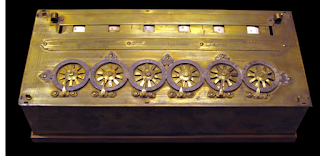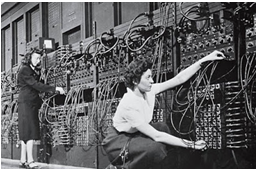History of computer
BRIEF HISTORY OF COMPUTER
In the hold days, pebbles and stones were used for counting
items, and marking on the well was the convection for storing the counts.
The discovery of zero by Indian mathematicians laid the
foundation of the number system.
Abacus, the first manual calculating device was developed in
and around 3000 BC and used in many countries particularly as toys for learning
while playing. It uses beads to represent decimal numbers. The Japanese call
it SOROBAN.
In early seventeenth century, john Napier, a Scottish
scientist who practiced mathematics as a hobby, developed another calculating
device known as 'Napier's Bones'. He used a set of eleven rods called 'bones'
with numbers carved on them. Napier is also well known for development of
logarithms in 1614. This idea of logarithm (combination of two Greek
words: LOGOS means ratios and ARITHMOS means numbers) by Napier, gave
birth to a calculating device called 'SLIDE RULE' which was used till the 1970s
in engineering collages. The slide rule was invented in 1620'by an English
mathematician, William Ought red.
 |
| Abacus |
In 1642 French physicist Blaise Pascal (1623-62)
at the age of 18 designed and developed the first mechanical calculator known
as 'Arithmetic machine' mean while, another Frenchman Joseph
Jacquard was a perfecting a system of hundred cards to
automatically control individual threads in a loom ,so that complicated
complicated design and patterns could be woven on the cloth.
 |
| Pascline |
In 1671, Leibnitz, the German mathematician invented the
first calculator for multiplication. It performed all the four basic arithmetic
operation- addition, subtraction multiplication and division.
 |
| Punch Card |
In 1820 Charles Xavier Thomas of France developed a
key driven calculator.
In 1823, Charles Babbage, an English professor of mathematics, in Cambridge University, developed a mechanical computer called difference Engine.Later, in 1833 Babbage designed an Analytical engine, but it could not be completed for want of developed the technology. But he paved the way for modern digital computers, because his Analytical Engine was built around the same five components (input, output, control, storage, memory, ALU) used in modern digital computer. Hence he know as the 'father of modem computer science'. His discipline a brilliant mathematician lady Ada Lovelace, the daughter of The Famous English poet Lord Byron, developed the binary number system for Babbage's machine. She is widely considered as the first programmer in the world, and the programming language ADA is named after her.
 |
| Difference Engine |
 |
| Analytical Engine |
In 1854, an English mathematician - George Boole, developed
two- state algebra called Boolean algebra, binary in nature. Claude Shannon, an
electrical engineer camp of wills its application to switching circuits that
led to the simplification circuits. It was George Boole who provided a missing
link between mathematics tricks and logic and it is log that is used in present
day computers.
In 1880, keyboard machines works originated in USA, and
are in use, even today.
In 1880, Dr Herman Hollerith was the first to put the
punched card technique to use in computation in 1890; he designed a punch card
device known as the census machine to process census data. The card machine
processed punch cards at the rate of 50 to 75 per minute.
In 1896, he set up the tube lighting Machine Company which
later becomes IBM, after a series of murgers.
 |
| Herman Hollerith |
In 1887, D.E felt designed a four Function calculator
knows as compote meter. The first keyboard calculator was introduced in 1911,
by R monrol. But the devices developed needed manual intervention, were slow,
lacked reliability and accuracy.
The first electro - mechanical calculator was designed in
1937 by Dr. Howard Aiken Harvard University, and produced by IBM in 1944,
known as Howard mark-I. It us more than 3000 relays, was 50 feet long
and 8 feet height. It took 0.3 seconds to numbers, and 4.5 seconds to
multiply 2 numbers.
Dr. JohnV. Atanasoff, a physicist at IOWA state college,
USA, in 1939 built the first electro digital computer, called
as ABC or Atansoff Berry computer. It used vacuum tubes and
the first entirely electronic computer.
ENIAC stands for Electronic Numerical integrator
and computer, and who was developed john Mauchly and John presper
at University of Pennsylvania USA in 1943. It was
electronic computer and was developed to cater to military needs. It
contained more than 18,000 vacuum tubes and needed huge electric power to run.
It was much more powerful lit mark I. ENIAC had two shortcomings: (I) its
storage capacity was very much limited, and its programs were Weed on board.
The operating programs could not be stored internally.
The EDVAC (Electronic Discrete Variable Automatic Computer)
was designed during 1946 - 52 on stored program concept to overcome
short comings of ENIAC by Hungarian born mathematician John Von
Neumann. He also introduced idea of storing both instruction and data and
binary form (0's and 1’s).
 |
| ENIAC ( The First Electronic Computer ) |
Prof. Newman, at Manchester University, in 1948 developed a
small experimental machine based on stored program concept. This was limited
only to store data and instructions.
The UNIVAC (Universal Automatic Computer was developed by
Remington Rand Corporation, US, was delivered to the U.S. census
Bureau in 1951 and was used for 10 year. The first commercial use of a
computer, a UNIVAC was by General Electric Corporation in 1954.
In 1952, the IBM - 701 Commercial Computer was developed by
International Business Machines (IBM). Other series were introduced in
1953 by IBM who produced the IBM - 650.
|
1953 |
International Business Machines introduced IBM 701
EDPM Computer |
|
1954 |
John Backus & IBM developed the first successful high
level programming language FORTAN. |
|
1955 |
Stanford Research Institute, Bank of America, and General
Electric developed the technology MICR (Magnetic ink character recognition)
for reading checks in banks. |
|
1958 |
Jack Kilby & Robert Noyce developed the integrated
Circuit known as IC or the Chip |
|
1962 |
The first computer game invented by Steve Russell &
MIT. |
|
1964 |
Douglas Engelbart developed the device Mouse. |
|
1969 |
The US Defense developed the ‘ARPAnet’ The original
Internet. |
|
1970 |
The world’s first dynamic RAM chip “INTEL 1103”developed
by Intel. |
|
1971 |
Faggin, Hoff & Mazor developed the first microprocessor
‘Intel 4004’ for computer. |
|
1971 |
Alan Shugart & IBM introduced the “Flopy” Disk |
|
1973 |
Robert Metcalfe & Xerox developed the Ethernet
Computer Networking. |
|
1974/75 |
The first consumer computers developed by Scelbi &
Marks-8 Altair & IBM 5100 Computers |
|
1976/77 |
More first consumer computers developed by like Apple I,II
& Trs-80 & Commodore Pet Computers |
|
1978 |
Dan Bricklin & Bob Frankston developed the first
Spreadsheet Software for PC named “VisiCalc” |
|
1979 |
Seymour Rubenstein & Rob Barnaby developed the word.
Processing software “WordStar” |
|
1981 |
IBM introduced The IBM PC the first Desktop Home Computer. |
|
1981 |
Microsoft introduced The MS-DOS Computer Operating
System software for PC |
|
1983 |
Apple introduced Lisa Computer – The first home computer
with a GUI, graphical user interface. |
|
1984 |
Apple introduced Macintosh Computer – The more affordable
home compouter with a GUI. |
|
1985 |
Microsoft introduced Windows. |



Comments
Post a Comment